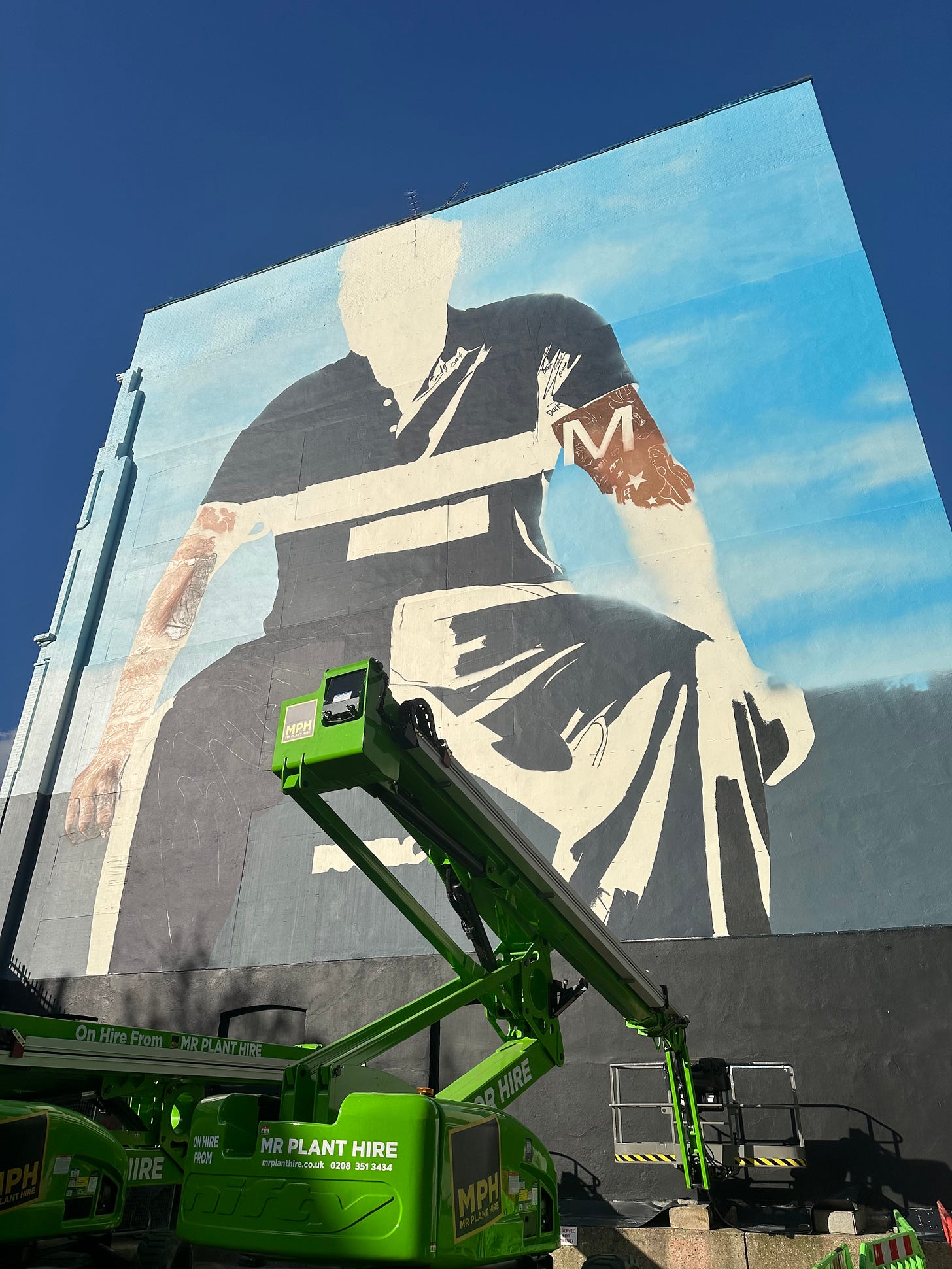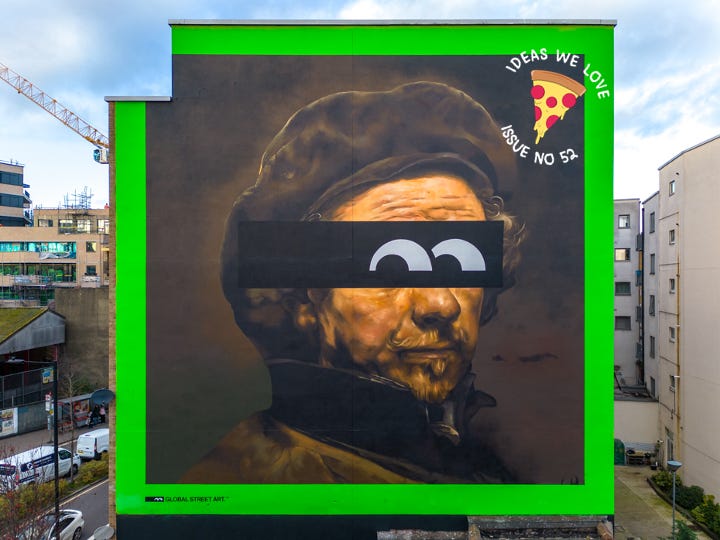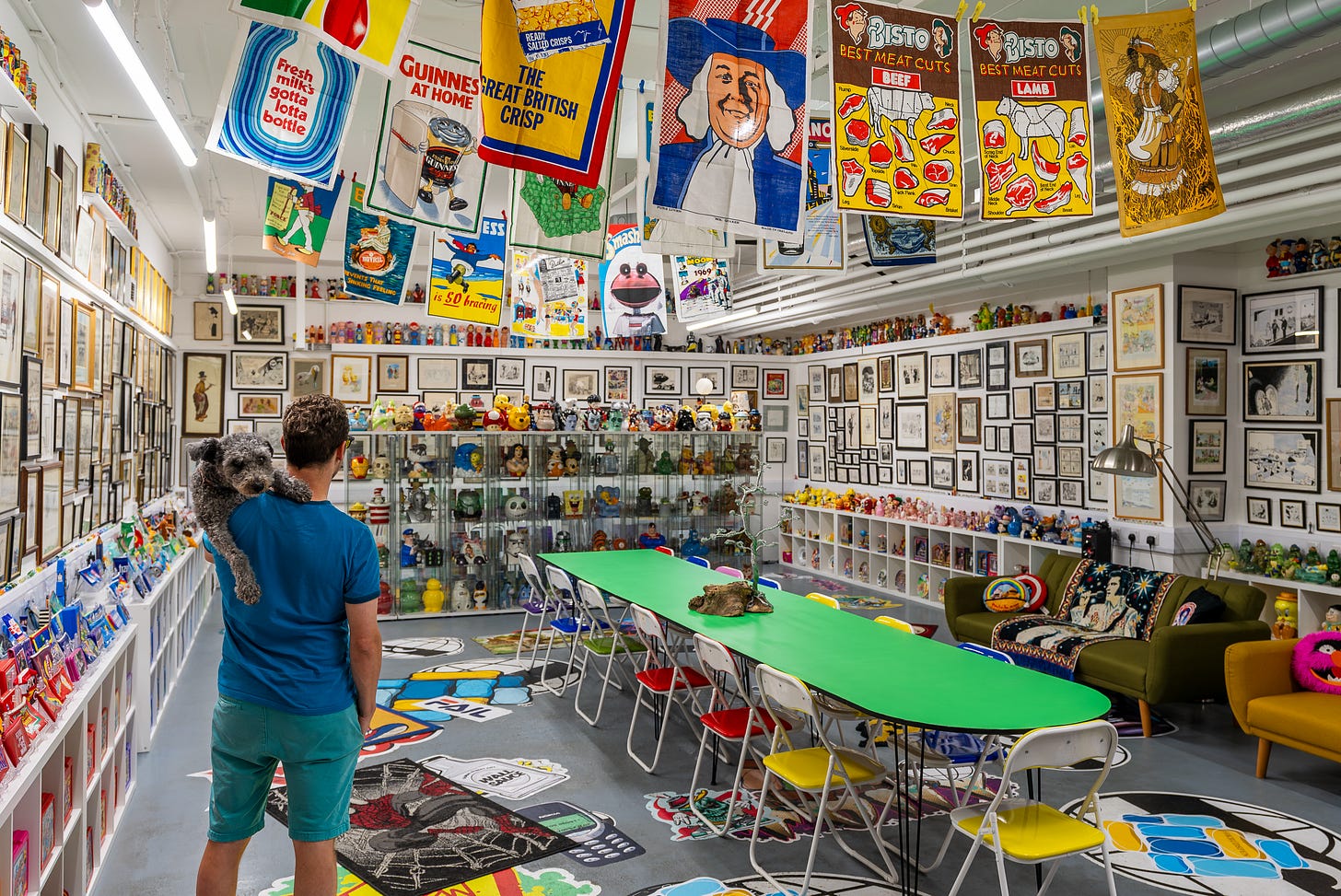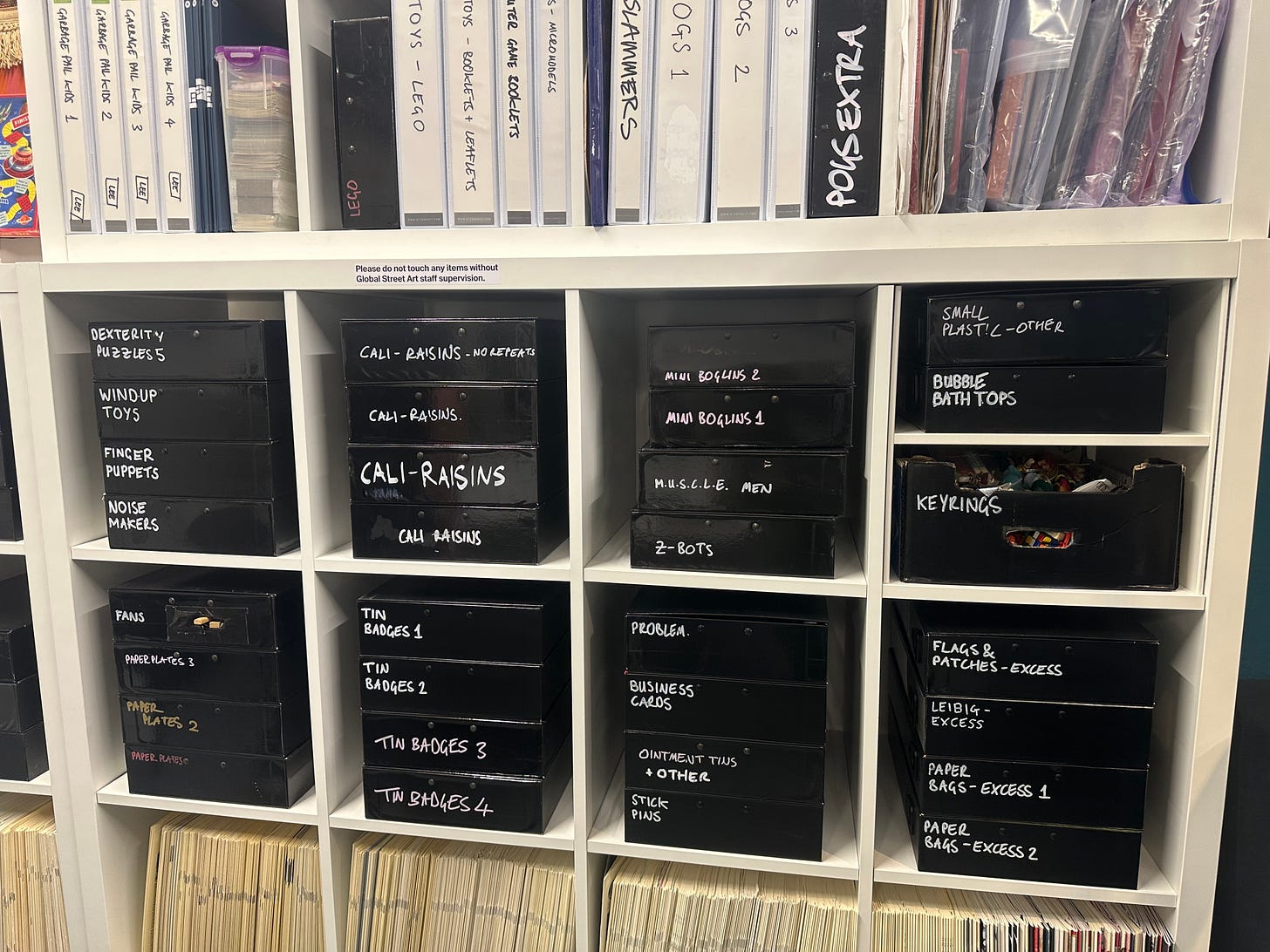Ideas We Love: Global Street Art
Issue Number 52: A conversation with Dr Lee Bofkin, CEO and Head of Inspiration at Global Street Art
Hi there.
It’s a been a minute. How are you?
A heady combo of illness, travel for work and leisure and a series of new projects over the last few weeks have kept us more than a little occupied. Sorry about that.
This week we have something a little bit different for you. Just before the Easter weekend we sat down with Lee Bofkin, CEO and Head of Inspiration at Global Street Art (GSA).
GSA’s work has featured in the newsletter a number of times. And if you’ve seen a handpainted mural for a brand or advertiser either IRL or in your Linkedin feed, then there is a good chance you’re already familiar with their handiwork.
They’re a creative business we deeply admire, so having exchanged a number of emails we took the trip across town to visit GSA’s HQ and Gallery near Old Street. We spent a whirlwind couple of hours with Lee, giving us the opportunity to take a look behind the scenes of GSA’s work but also the opportunity to discuss everything from the work GSA does with brands and artists, the origins of their vast archive, and a whole host of things in between.
A big chunk of the work that Lee and his team do falls into the territory that you might typically ascribe to a ‘media owner’ : they take briefs from agencies and brands and then place murals, painted by hand, onto any number of ‘walls’ that they exclusively manage for commercial purposes.
The media owner label feels a little bit reductive, somehow. The murals they produce are just one part of what they do: the GSA team are building a fascinating and vibrant creative company driven by core mission to see us all ‘Live in Painted Cities’.
What a nice thought.
In addition to their commercial work, Lee has built up a collection of over 100,000 cultural knick-knacks which are housed at GSA’s Shoreditch HQ, next to their workshop. The “Gallery” the company has built regularly plays host to all sorts of people and the space and the artefacts within it are used a vehicle through which Lee teaches people to see objects around them as a vehicle to unlocking their own creativity.
Beyond their work for brands, GSA also takes an active role in bringing Street Art to communities via partnerships with local authorities. They put on city-wide exhibitions like last year’s London Mural Festival. They support artists with materials and spaces to ply their trade and express themselves.
We hope you enjoy the conversation!
IWL: Do you know what the first item was in your collection. How did you start it?
Lee: The first real items that I got into were nightclub flyers in the early nineties when I was growing up in North London. I lived close enough to the record shops to get the Flying Squad and Don't Panic flyer packs. And I had them all over my bedroom wall and I never threw them away. They're still part of the collection today. They've come back into fashion as well. I had a family that collected little bits and pieces. I enjoyed collecting 'cause I just had an attraction to stuff that was in order. So, I guess I’ve always collected.
Before an injury stopped me, I used to break dance. I would collect moves and had a very clear understanding of my own ‘vocabulary’ of moves. When I stopped, I went around the world taking pictures of graffiti. I took 50,000 photos in 25 countries of Street Art before it became as popular as it is today.
That trip was driven by the same collector's instinct. I couldn't understand at the time why I loved the graffiti stuff and other people didn't.
IWL: Does the collection play a role in your commercial work for brands?
Lee: My ‘training’ has been in classifying things. I don’t understand lunchboxes or pencil cases more than the average person before I collect them. I start with a sense that they’re interesting though and have something to say and I am sensitive to the stories they tell.
The specific role of the collection in our work today has changed. So as an example, Fendi called and they said “look, we've got a seven story high wall in Miami. Can you come up with a creative concept for it?”
Because it was Miami, it reminded me of some mid-century American postcards that we have in our voluminous paper archive. Beautiful type, really good for tourism. And so we built an idea off the back of that and the concept was postcard from Miami. The artwork became a postcard from Miami sent to Rome, but with loads of elements influenced by the Fendi brand. We put their logo in the preexisting space on the wall. The sun is Fendi yellow. There were loads of Easter eggs to make it interesting for real fans. The man on the postage stamp is Fendi’s founder. The squirrel in the postmark is Fendi’s original logo…and it’s addressed to Fendi’s HQ as well.
Mostly we use the archive as a vehicle to talk and educate to people about visual culture, advertising and creativity, and hopefully have people inspired when they leave. But, the archive does help us when we work with brands and it stops us facing a blank sheet of paper for too long when working on new briefs.
IWL: You have talked about ‘not setting out to work in advertising’, what did you see as the opportunity in Advertising that was going unmet when you started?
Lee: I don't think we explicitly saw an opportunity in advertising. We saw something that was a bit uncomfortable: I couldn't just understand or process why the super talented artists that we worked with didn't seem to be in demand.
The opportunity landed on us. Really, were interested in street art and graffiti and taking the photos. We were splashing around in the water when the wave came. And that wave was social media and digital, which helped find a place for hand-painted advertising.
When you look at, there's 16,000 digital out of home (DOOH) screens in the UK. You buy a one in six or one in five slot. Consumers are on a screen, 10 or 12 hours a day, whatever it is. Another screen doesn't strike me as being the most natural delivery mechanism to get more attention.
We offer brands a ‘one of one’ advertising space and our dwell time and engagement is really high as a result. If you are on the bus in the morning and we take five days to paint a wall, when you go past on that bus, you just look out the window at the guys on a lift painting the thing. By day five, you're invested. You've seen it change every day. You take a photograph. What we found really funny is that the dwell time when something is finished is high but we know it’s even higher when we’re painting.

IWL: How does your community led work like the London Mural Festival and your work with local authorities intersect and interact with your commercial work for brands?
Lee: If I'm honest, our community work hasn't interacted much with brands. I think there could be amazing possibilities where we might have tried to raise partnership funding for the London Mural Festival last year. It was a difficult environment for partnerships - and we were a little late to the party. It cost us a lot of money to put on in the end. But we stand by our mission of wanting to live in painted cities, so there came a point where we said that we were going to go ahead and do it anyway, irrespective of the cost.
The net cost for the entire project was about the same as Tower Hamlet's Anti Graffiti cleaning budget. There is an interesting thought in repurposing the budget for cleaning graffiti and turning it into mural production budgets, you could end up with a vastly more beautiful city as a result of that change.
IWL: Which new and emerging artists are you excited about in particular? Which brands would you love to team them up with?
Lee: We’ve set up healthy group working dynamics within the studio so people here are building on each others ideas and we've seen really good ideas come out of this room from the team. Now that's really fun. Even though we paint mostly the artwork that we receive, when we are given the opportunity to design artwork with people like Fendi we do it really well because we've got a bunch of people in house who've got really highly trained sense of style, they can apply it to walls and they know our process deeply from end to end.
A lot of the people that I think are quite exciting are visual artists, but not necessarily painters. So there's one person that I'll say, and I hope he doesn't mind me mentioning him and that's Tom Curtis. He's an ECD at EssenceMediacom. But he just happens to have a million followers on his Instagram account because he's got a really funny idea that he's been doing for years - it’s called Things I have Drawn. I would bite my own arm off to work with Tom and someone KitKat, specifically. I love the idea of having a break and I and really want to paint some absolutely terrible, shocking murals for them. Imagine an influencer’s reaction seeing a mural of them painted awfully – it would be hilarious. Fade to black: have a break.
IWL: It feels reductive and wrong to talk about the distinction between ‘digital’ and ‘analogue’ art or media in 2025. Having said that it’s clear you’re believers in the physicality of your work and the fact that leads to output worth paying attention to.
How do you think about bringing your work to life within digital or online environments?
Lee: We subscribe to the idea that if a piece of art works physically and in the real world, it also works digitally. If we make something amazing on a wall people will photograph it and share it, and therefore it works naturally, in digital environments. The opposite isn’t always true though.
IWL: That feels like a very powerful observation. And not one we’d necessarily thought about before. How are digital tools being used in your work, if at all?
Lee: I'm using AI for lots of different things, though not as much on the design front because the output has a tendency toward the overcomplicated.
The training set for AI images is skewed towards digital resources. That means most of what AI imagery is trained on is digital images produced in the last 10 years or 20 years. We’ve trained these AI tools on a very small subset of visual history. If you think advertising was clearer and communicated better in the sixties, you are better off not using AI to help you create advertising (without conscious instruction and explicit personas).
I find it quite interesting asking what AI can't do. It’s important to remember these tools are only as good now as the prompt that you give it. And so people are still really valuable for inspiration in the creative process, even where these tools are concerned.
IWL: What’s the biggest thing you’ve learnt about yourselves running the business?
Lee: The biggest thing I've learned about myself is that the team is obviously everything. Our culture is really important. We're only really just learning as an organization about the value of training and more formal training as well. What got us here won't be the thing that gets us to the next stage.
Scaling is a skillset. So we've had to learn and we are learning a completely different set of skills, especially as we've gone international. My role has changed over time from builder to gardener.
Fundamentally, at the start I had the plan, did a lot of the stuff, I did so much of the work. Now it's more about fostering the environment for people to flourish. That takes a lot of effort to go from one mode to another. It’s been a journey.
IWL: And do you identify more as the ‘builder’ or the ‘gardener’?
Lee: A builder. I love doing the work. I still really enjoy it. I love being on client calls. I love seeing things get painted. I would probably be happy if I could still be on the lift most days. Having said that though, increasingly the biggest pleasure about my job now is this idea of being an inspiration partner – that’s relatively new. Being able to bring people into the gallery and having them walk out again feeling inspired and having learnt something. Our clients are out of market 95% of the time anyway, marketing lore, but who is ever out of market to be inspired?
IWL: What advice would you give to someone starting a creative, communications led business today?
Lee: Keep going and be nice to people. That’s the best I have right now!
Until Next Time
What a great thought to finish on from Lee: keep going and be nice to people. That’s advice we think we could all benefit from… especially with everything going on out there….
Thank you again to Lee Bofkin for being such a lovely and interesting and generous person to spend a couple of hours with. We certainly left feeling excited and more than a little bit inspired. If you’re in the market for some creative inspiration or want to find a new way to exhibit your brand, then give the guys at Global Street Art a call.
Until next time
Cheerio,
Tom & Matt x












